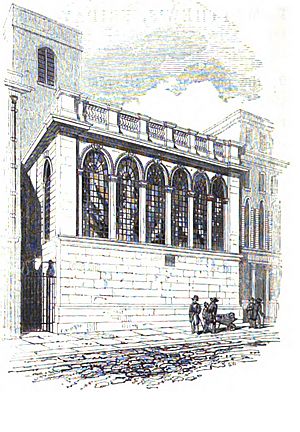St Matthew Friday Street facts for kids
Quick facts for kids St. Matthew Friday Street |
|
|---|---|
 |
|
| Location | Friday Street, London |
| Country | United Kingdom |
| Denomination | Church of England |
| Architecture | |
| Architect(s) | Christopher Wren |
| Style | Baroque |
| Demolished | 1885 |
St. Matthew Friday Street was an old church in the heart of London, on a street called Friday Street, near Cheapside. People knew about this church since the 1200s.
Sadly, the church was destroyed in the terrible Great Fire of London in 1666. It was then rebuilt by the famous architect Christopher Wren and his team. However, this rebuilt church was taken down in 1885.
Contents
The Church in Medieval Times
St. Matthew Friday Street was special because it was the only church in the City of London named after Matthew the Evangelist. He is known as the patron saint of accountants.
Friday Street got its name because fish sellers used to work there. Cheapside was the main market street in medieval London. Many smaller streets nearby were named after what was sold there, like Milk Street or Bread Street. So, it's likely Friday Street was where fish was sold on Fridays.
The first time this church is mentioned in old papers is around the 1200s. It was called "St Matthew in Fridaistret." Later, in the late 1300s, it was also known as "St. Matthew in Chepe."
Events in the 1600s
In 1631, a man named Hugh Myddleton was buried at St. Matthew Friday Street. He was an important businessman who created the New River to bring fresh water to London. He lived in the area and helped manage the church. When the church was taken down much later, people tried to find his grave but couldn't.
During this time, the church's leader was Henry Burton. He was a Puritan, a type of Protestant who wanted simpler church services. In 1636, he spoke out against changes made by William Laud, who was a powerful church leader. Burton believed these changes were making the Church of England too much like the Catholic Church. For speaking out, Burton faced severe punishment.
Even after this, St. Matthew's church kept its connections with people who disagreed with the main church rules. In 1662, a new law called the Act of Uniformity 1662 made a specific prayer book, the Book of Common Prayer, required in all churches. The church's minister, Henry Hurst, was removed because he didn't follow this new rule.
On the day the law started, August 24, 1662, a famous diarist named Samuel Pepys wrote about a disturbance at St. Matthew Friday Street. He said young people were shouting "Porridge" in the church. "Porridge" was a nickname Puritans used for the Book of Common Prayer. Some even said they tore up the book. Pepys thought this was a bad sign.
Just four years later, in 1666, the Great Fire of London destroyed St. Matthew's, along with most other churches in the city.
Rebuilding After the Great Fire
After the fire, the area around St. Matthew's church was combined with the nearby St Peter, Westcheap parish. St. Peter's church was not rebuilt, but its churchyard became a public garden that you can still visit today.
The people in charge of rebuilding churches thought about moving St. Matthew's to a new spot. But they decided to rebuild it on its original site. They even added a bit more land to make the church bigger. Building started in 1682 and finished in 1685. The total cost was about £2,309.
St. Matthew Friday Street was the smallest and cheapest church rebuilt by Christopher Wren. It had an unusual, uneven shape inside. It was a simple room with a flat ceiling. There was a small organ at one end. The outside walls were mostly brick, but the front facing Friday Street was made of stone. The church's tower was very plain and hidden from the street. It only had one bell. People entered the church through narrow paths on the sides.
Some parts of the old St. Matthew's church are still around today. Its communion table and Royal Arms are now in St. Vedast-alias-Foster church. The font (for baptisms) and pulpit (where sermons are given) are in St. Andrew-by-the-Wardrobe church.
Demolition of the Church
In the late 1800s, many people moved out of the City of London to live in the suburbs. Because of this, St. Matthew's church was no longer needed. It was torn down in 1885 under a law called the Union of Benefices Act 1860.
The land where the church stood was sold for £22,005. This money was used to build a new church called St. Thomas Finsbury Park. The parish was then joined with St Vedast alias Foster.
A beautiful wooden screen from St. Matthew's, called a reredos, was saved. It was bought by a decorating company. They suggested to a famous hostess named Margaret Greville that it should be put in her house, Polesden Lacey, in Surrey. It's still there today. This screen has two tall columns and originally held the Ten Commandments.
The part of Friday Street where the church once stood was destroyed during World War II. New buildings were built over the area in the 1950s. The exact spot of St. Matthew's church is now part of a courtyard.
Organ and Organists
A new organ was built for the church in 1762 by George England.
Organists of St. Matthew's
- John Young (1735-1767)
- Martin Rennoldson (1767-1802)
- William Boyce (1802-1812)
- John Cash (1812-1815)
- Thomas Grady (1815-1817)
- J.C. Webb (1818-1830)
- Miss Lea (1830-1835)
- Mrs Andrews (1836-1878)

